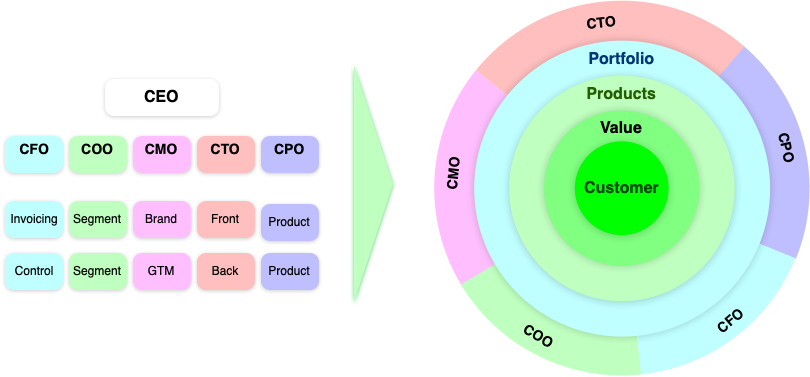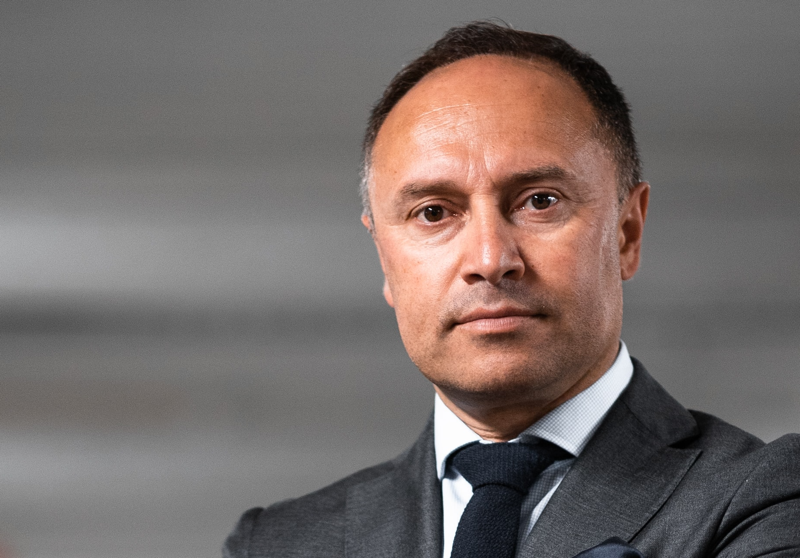How to organize your executive team to deliver customer-centric Agile Digital Transformation? | Vincent Henderson

There are different ways that legacy organizations can accomplish Digital Transformation, depending on how business dynamics determine the organization structure. Find the right one for you. Let's look at some options.
The CEO drives the Digital Transformation from the executive committee
In some organizations, the CEO is the holder of the digital transformation vision and manages the business with their executive team. In that case, a natural situation is that executives leading each division run their own digital transformation programs. This requires a mature C-level team that can carry the vision and has the requisite expertise.
Each unit leader would give some autonomy to the program leaders in each unit to coordinate between themselves. The CTO teams would typically lead the Digital Transformation programs through their program management function, as they will involve most resources from their division. They will then report back to and coordinate dependencies with the executive team.

This setup typically indicates a relatively static Digital Transformation. Yes, the executive focus at the CEO level is conducive to effective programs that deliver digital change. However, giving the existing executive team the task of each digitizing their own unit all but guarantees that the business model and the supply chain will not be changed. It will leverage a lot of process efficiencies, and identify some interesting product innovations. But it will very likely fall short of being able to deliver the Agile customer-centric business transformation, because of entrenched interests and cognitive biases of the existing leadership.
The CEO needs a dedicated Digital Transformation leader
There are organizations where the CEO wants to empower a strong Digital Transformation drive but can't be the driver themselves. This can be because the executive team recognizes that they don't have the leadership expertise required to autonomously drive such programs.
It can also be because the legacy business organization is organized such that any foreseeable customer-centric Agile Digital Transformation initiative would have to cut through multiple units horizontally, with critical dependencies between them. This makes loosely connected independent programs unlikely to succeed, and creates too many failure points and moving parts for an executive team to track.
Last but not least, the CEO may also realize that comprehensive Agile customer-centric digital business transformation will require modifications to the structure of the business itself, and hence its management structure, and must therefore be run by a leader who is not invested in the status quo.
In this case, the CEO needs to secure the support of a dedicated empowered executive. This leader will join the executive team and take charge of the horizontal business process of Digital Transformation.

The Law Firm Managing Partner needs a Digital Transformation leader
In the case of Law Firms, the situation is a little more straightforward. Legal Partners are the main revenue earners, and they typically can't focus much on business operations the way some CEOs do. To transform their firm, they need to decide to allocate a staff position to Digital Transformation. This executive leader will work with the Law Firm's executive committee, Practice Heads and senior staff to work customer-centric Agile Digital Transformation into the Firm's practice.
The firm's leadership will provide support and leverage to support the initiatives, but the Digital Transformation leader will need to be particularly attentive to delivering value that is highly visible and recognizable to fee earners, as the allocation of their time is entirely driven by revenue-generating considerations.
LegalTech is an important disrupting force in the legal industry, and dedicated expert leadership needs to take this challenge on.

Corporate Legal Departments need special Digital Transformation care
Corporate Legal Departments are in a special situation compared to other units. They are typically both culturally and operationally relatively isolated from operational and administrative units. They may report to the CFO or be a distinct department, but their key problem in life is that they are run on knowledge and skills that have nothing to do with the rest of the business. They tend to be perceived as observers of the business from the side and often don't have operational budgets to speak of beyond a budget for law firms and legal staff.
LegalTech provides a useful focus on the legal business process which CLDs know they need to leverage.
If you're a large CLD, then youcan probably justify a role for running the Digital Transformation of your legal operations. Otherwise, you're likely going to have to find a spot on the broader Digital Transformation initiatives.

Support functions are broad enough to justify their own Digital Transformation efforts
Under the leadership of CFOs, who also often run special programs, Digital Transformation has been a thing for quite some time. What we now call RPA, i.e. the reduction of all sorts of processing costs through automation, was driven by outsourcing vendors to improve the attractivity of their offer for at least two decades, and the practice has generalized.
In some organizations of a certain size, the CFO has a PMO organization to lead special projects, generally focused on Operational Excellence, LEAN Six Sygma (LSS) performance programs and the like. Digital Transformation has sometimes found a home there. But these days, Digital Transformation is the driver, it's no longer a sub-category of projects. Digital technology is what drives the efficiency opportunities.

It's rare that CFO-driven Digital Transformation initiatives result in deep transformation of business models. By nature such programs will lead to efficiencies, centralization of resources and other incremental of organiztional optimizations.
However, a key risk to avoid in these CFO-driven programs is to focus on over-optimizing for the current business model, extract every penny of savings from it, and as a result crystallize it rather than make it more efficient from the point of view of adaptability. We can't future-proof an organization at the same time as we're minimizing resources and maximizing utilization. We have to make sure to pick the battles wisely.
The common denominator is the market and customers
These situations are obviously toy models, and the real world of running businesses has many variants of these canonical cases, and the "dotted-line reporting" paradigm that any group of a certain size operates under these days has led to all sorts of organizational, er, innovations.
Either way, however your business is organized, if you want to succeed in your customer-centric Agile Digital Transformation, you need to make sure of three things:
- Whatever the internal goal of your transformation initiative, make sure that the deliverables of the program are defined in terms of how they improve your customer's experience with your product or services
- Drive the program through an Agile framework, ensuring that people with the most ability to do the work to reach the goals work together in empowered multidisciplinary teams
- Define as a clear program goal that the program must not only deliver change, but also future ability to change
In other words, your customer-centric Agile Digital Transformation must function as a Product Development activity, where your target "Product" is not just the actual products, but also the organization itself as a future value-generating machine.
Use your knowledge product portfolio as the driver for change
If you're a company with a stake in the knowledge economy, i.e. relying on curating data and information to produce products powered by knowledge that experts use to do their job, then your customer-centric Agile Digital Transformation is literally a Product Development activity.
In that case, you're changing your product's supply chain. That means you're changing your product and this must be governed by the owner of the product portfolio. In these knowledge organizations, these are either a Chief Product Officer or Chief Operations Officer. The overlap between Operations and Product in such businesses is so significant that distinguishing the two can be sub-optimal.
It's interesting to note that, for businesses making physical technology products as opposed to pure knowledge products, it's the digital knowledge ecosystem around applications for designing and managing physical products that, for all intents and purposes, operates in the scope of the knowledge economy paradigm. It is often the case in such businesses that the Chief Digital Officer is the ultimate owner of the knowledge products.

Who am I?
I'm Vincent Henderson, Chief Product Officer, Chief Digital Officer or Chief Operations Officer for knowledge-driven businesses. I lead the complete knowledge value chain, from sourcing to processing, delivery, product design and Product Management.


